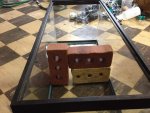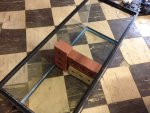I pulled this off a clay brick manufacturing site. Clay contains a number of impurities, the firing and glazing procedures aim at hardening and creating a waterproof brick, however leaching may still occur. Other style of brick contain even more impurities .What effect the leaching will have to the aquarium water and the axolotl is something i am not qualified to say but any chemists or biologists might be able to clear this matter up
The clay substance may vary from 15 to 80%, the free silica or
sand from 5 to 80%, the oxide of iron from I to 10%, the carbonates of
lime and magnesia together, from I to 5 %, and the alkalis from I to
4%. Organic matter is always present, and other impurities which
frequently occur are the sulphates of lime and magnesia, the chlorides
and nitrates of soda and potash, and iron-pyrites."
The minerals found in common clay are
biotite, illite, muscovite, and sericite; other minerals, such as
kaolinite, smectite-group clays (montmorillonite, saponite,
nontronite, and so forth), mixed-layer clays, and chlorite, also are
present in many deposits. Common clay is usually higher in alkalies,
alkaline earths, and iron-rich minerals and lower in aluminum than
ball clay, fire clay, and kaolin. Common clay is mined in hundreds of
places across the United States.




